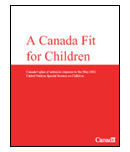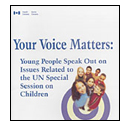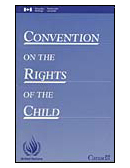Common menu bar links
Institutional links
Diseases & Conditions
Health & Safety
Research & Statistics
Agency Information
Search Box
What is National Child Day
This day marks the adoption by the United Nations of the Convention on the Rights of the Child ![]() in 1989.
in 1989.
In 1993, the Government of Canada enacted Bill C-371, otherwise known as the Child Day Act, and designated November 20th of each year as a national day of the child in order to promote awareness in Canada of the Convention.
The Convention spells out the basic human rights to which children (under the age of 18) everywhere are entitled.
Find out more about National Child Day
What are Children's Rights?
By ratifying the United Nations Convention on the Rights of the Child in 1991, Canada made a commitment to ensure that all children are treated with dignity and respect. This commitment includes that they be given the opportunity to have a voice, be protected from harm and be provided with their basic needs and every opportunity to reach their full potential.
The Convention is based on four cross-cutting principles:
- The best interests of the child should be the first consideration for actions that affect a child;
- All children have the right to life, survival and development;
- All children have the right to participate; and,
- All rights belong to all children without discrimination or exception.
Some examples of rights are:
- The right to have a voice in matters that affect children;
- The right to special education and care;
- The right to play and rest;
- The right to health; and,
- The right to special protection.
The Convention also acknowledges the key role of parents and families in the lives of children and young people.
More about National Child Day
In May 2002, more than 7,000 people from around the world gathered in New York to take part in the United Nations General Assembly Special Session on Children, the most important international conference on children in more than ten years. The Special Session on Children reviewed progress since the World Summit for Children in 1990, identified barriers and emerging issues; and committed the international community to the world's children for the coming decade. At the conclusion of the Special Session on Children, the General Assembly adopted by resolution, A World Fit for Children, a declaration and plan of action.
Released in May 2004, A Canada Fit for Children, Canada's national plan of action for children was developed in response to A World Fit for Children. This plan contains a declaration of Canada's commitment to children: a Canadian vision for children that highlight a plan of action reflecting a consensus of goals, strategies and opportunities for action.
Celebrating National Child Day is about celebrating children as actors in their own lives and in communities, as active citizens who can and should meaningfully contribute to decision-making as we create a Canada fit for children.
Publications
| A Canada Fit for Children | HTML |
 Canada 's plan of action in response to the May 2002 - United Nations' Special Session on Children. |
|
| A World Fit For Children | HTML |
 The new agenda for - and with - the world's children, including 21 specific goals and targets for the next decade. More than two years of consensus-building resulted in a strong future agenda focused on four key priorities: promoting healthy lives; providing quality education for all; protecting children against abuse, exploitation and violence; and combating HIV/AIDS. |
|
| A World Fit for Us | HTML |
This message from the Children's Forum, was delivered to the United Nations General Assembly Special Session on Children by child delegates, Gabriela Azurduy Arrieta, 13, from Bolivia and Audrey Cheynut, 17, from Monaco on May 8, 2002. |
|
| Your Voice Matters | HTML / PDF |
 Your Voice Matters: Young People Speak out on Issues related to the UN Special Session on Children In November. 2000, Health Canada developed an interactive Web site to provide children and adolescents with an opportunity to express their views about their priorities and thoughts on issues related to the United Nations Special Session on Children. The results of the Health Canada National Child Day initiative are presented in this report. |
|
| Say It Right | HTML |
 The Unconventional Canadian Youth Edition of the United Nations Convention on the Rights of the Child. "We have the right to be listened to.... Our friends, family, teachers and governments can all help us exercise our rights better in many situations. We need to let them know when they are helping us, and if they aren't, what they can do differently. So let them hear you SAY IT RIGHT! " |
|
| Convention on the Rights of the Child | HTML |
 The human rights of children and the ways governments can make them happen are most clearly described in one international human rights treaty: the United Nations Convention on the Rights of the Child. |
|
